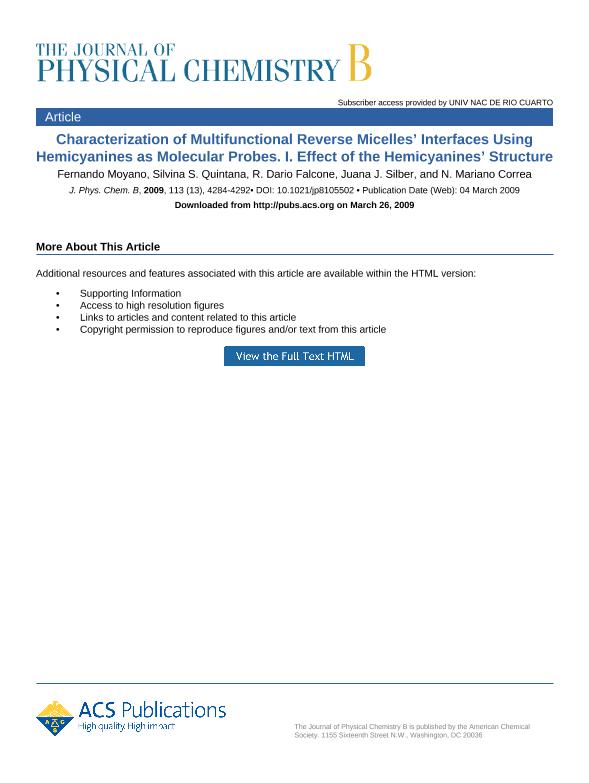Artículo
Characterization of multifunctional reverse micelles' interfaces using hemicyanines as molecular probes: I. effect of the hemicyanines' structure
Moyano, Fernando ; Quintana, Silvina S.; Falcone, Ruben Dario
; Quintana, Silvina S.; Falcone, Ruben Dario ; Chessa, Juana Josefa
; Chessa, Juana Josefa ; Correa, Nestor Mariano
; Correa, Nestor Mariano
 ; Quintana, Silvina S.; Falcone, Ruben Dario
; Quintana, Silvina S.; Falcone, Ruben Dario ; Chessa, Juana Josefa
; Chessa, Juana Josefa ; Correa, Nestor Mariano
; Correa, Nestor Mariano
Fecha de publicación:
04/2009
Editorial:
American Chemical Society
Revista:
Journal of Physical Chemistry B
ISSN:
1089-5647
e-ISSN:
1520-6106
Idioma:
Inglés
Tipo de recurso:
Artículo publicado
Clasificación temática:
Resumen
In this work, we report the behavior of two different hemicyanines, trans-4-[4-(dimethylamino)styryl]-Nmethylpyridinium iodide (HC) and 4-[4-(dihexadecylamino)styryl]-N-methylpyridinium iodide (DIA), in water/ sodium 1,4-bis-2-ethylhexylsulfosuccinate (AOT)/benzene reverse micelles media using absorption and emission spectroscopy in addition to the steady-state and time-resolved fluorescence emission techniques. Our results show that the AOT reverse micelles interface has the nontrivial deaggregation property, a result that may have potential application for the preparation of dye lasers, which require a noninteracting monomeric form of the dye. Also, we show that the water interacts with a different region of the AOT moiety depending on the external organic solvent used and, in addition, we also present a nice, simple, and noteworthy method that helps to examine the presence or the absence of organized media. In conclusion, our results show that HC and DIA are powerful dyes to characterize simultaneously different interfaces' properties as they can be used to sense, at the same time, fluidity and specific interactions at the interface. These results are important because those properties are the key for molecular recognition.
Palabras clave:
reverse micelles
,
AOT
,
Hemicyanines
,
emission spectroscopy
Archivos asociados
Licencia
Identificadores
Colecciones
Articulos(OCA HOUSSAY)
Articulos de OFICINA DE COORDINACION ADMINISTRATIVA HOUSSAY
Articulos de OFICINA DE COORDINACION ADMINISTRATIVA HOUSSAY
Citación
Moyano, Fernando; Quintana, Silvina S.; Falcone, Ruben Dario; Chessa, Juana Josefa; Correa, Nestor Mariano; Characterization of multifunctional reverse micelles' interfaces using hemicyanines as molecular probes: I. effect of the hemicyanines' structure; American Chemical Society; Journal of Physical Chemistry B; 113; 13; 4-2009; 4284-4292
Compartir
Altmétricas



